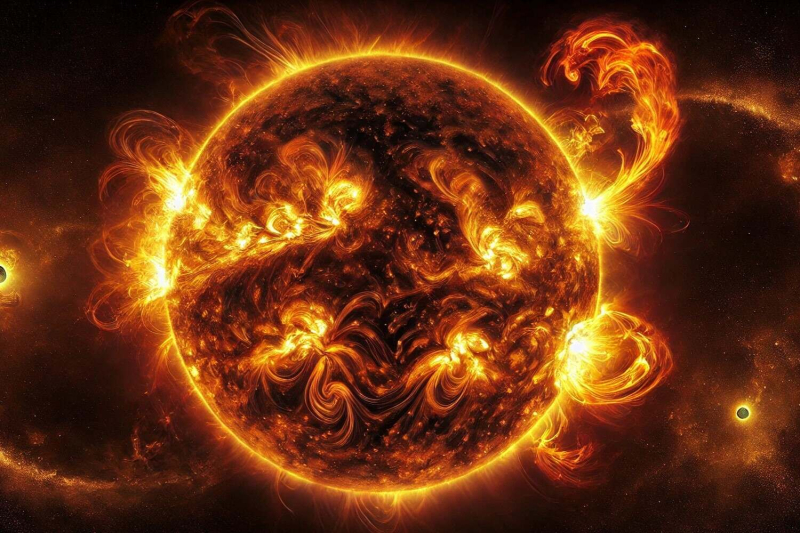
© Image generated by AI DALL-E for Presse-Citron
Our Sun is not just a quiet ball of fire; like all stars, it is the seat of nuclear reactions that produce colossal energy and influence our entire solar system. In May, this video reminded us of this in a rather spectacular way. On its surface, astonishing and potentially disruptive phenomena for our planet take place: solar winds (sometimes producing northern or southern lights), storms and solar flares.
Among these, these eruptions fascinate as much as they worry. Our star has just experienced a particularly intense activity, the perfect opportunity to decipher this phenomenon.
Solar Fury: when our star erupts
A solar flare is a sudden and massive release of energy on the surface of the Sun. These events occur when the magnetic energy accumulated in the solar corona (the outermost part of its atmosphere) is suddenly released. Just like a rubber band that is pulled too hard and eventually snaps. Scientists classify these eruptions according to their intensity, from A to X, the latter category representing the most powerful.
A solar flare is often accompanied by coronal mass ejections (CMEs), a kind of bubble of plasma and magnetic fields that is projected from the star. This bubble can reach gigantic sizes and propagate through the solar system at considerable speeds. The violence of these events can be considerable: a class X flare releases an amount of energy that is absolutely insane on a human scale.
The energy released by a single class X flare can reach several billion megatons of TNT. For comparison, the atomic bomb dropped on Hiroshima had a yield of about 15 kilotons of TNT. Theoretically, a Class X eruption is therefore more than 60 billion times more powerfulthan this bomb. This figure remains a simple average, X-class flares are all different in the energy they release.
At the beginning of October 2024, the Sun has just graced us with a veritable cosmic fireworks display. A colossal X9-class flare, the most violent of the current solar cycle, illuminated its surface on October 3 (see video below). This titanic explosion may well have propelled a gigantic mass of solar plasma toward us, perhaps heralding a turbulent weekend for our magnetosphere (Earth's protective shield).
All eyes are turning to sunspot AR3842, a veritable plasma cannon that, a few days earlier, had already spat out an X7.1-class flare. Astronomers are in a frenzy, scanning the sky for theearly signs of a geomagnetic storm, an intense and rapid disturbance of the Earth's magnetic field, caused by the interaction between the solar wind and the Earth's magnetosphere.
200% Deposit Bonus up to €3,000 180% First Deposit Bonus up to $20,000Subscribe to Presse-citron
What impacts on our blue planet
When a solar flare is pointed at Earth (as was the case with the one on October 3), its effects can be considerable, even if its effects are not instantaneous. As explained above, the interaction between the ejected particles and our magnetic field can generate geomagnetic storms. These disturbances are so powerful that they can affect our communication systems, our electrical grids and even the proper functioning of our satellites.
These charged particles induce powerful electrical currents in the Earth's atmosphere, disrupting the electrical and communication grids that depend on our magnetic field. The intensity of these storms is measured on a scale ranging from G1 to G5. A G3-class storm, like the one expected with this eruption that just occurred, can already cause significant disruptions.
In extreme cases, a G5 storm could cause widespread blackouts and lasting damage to our infrastructure; the most recent occurred in May of this year. The most famous G5 is certainly the Carrington Event of 1859. This extremely powerful geomagnetic storm caused the northern lights to be visible as far away as South America and caused outages in the telegraph systems of the time. One can easily imagine the deleterious effects that this would have had today, given our extreme dependence on technology, and therefore on electricity.
Our star's activity follows a cycle of about 11 years, alternating between periods of relative calm and phases of intense activity. We are currently in an ascending phase of this cycle, which explains the recent resurgence of powerful flares in recent months. Understanding these phenomena is essential to anticipate their potential effects on Earth. This is why many space and weather agencies, such as NOAA in the United States, are working tirelessly to refine their forecast models. A blackout like the one in 1859 would be absolutely catastrophic: widespread power grid failures, disruption of satellites and communications, internet and mobile network outages, freezing of financial systems, failure of medical infrastructure and compromise of the security of nations. A True Technological Apocalypse.
- Solar flares release massive amounts of energy that can disrupt power grids and satellites on Earth.
- A recent X9-class solar flare could cause a geomagnetic storm to affect our planet this weekend.
- A blackout like the one in 1859 would cause massive outages, disrupting communications, power, and critical infrastructure.
📍 To not miss any Presse-citron news, follow us on Google News and WhatsApp.

